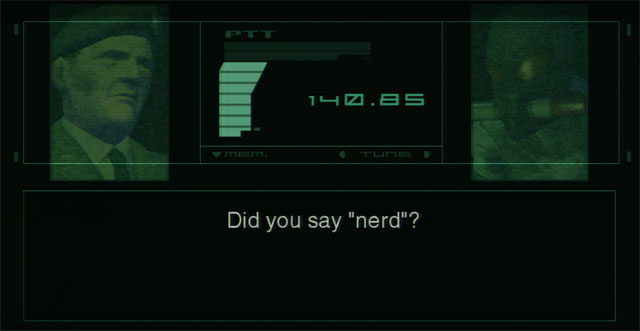
Doesn’t matter, I’m here anyway.
So wait, [impossible thing]!?
For most of these answers I’m going to assume the question is being asked in good faith, and respond appropriately. Before that, though, I need to swat away many thousands of mildly obnoxious questions by assuming they aren’t asked in good faith. It’s important to understand that “Unanswered Questions in X!” style clickbait lists are usually not written from the standpoint of a sincere fan seeking clarification, but from that of an internet humorist making fun of confusing stories. The story of the Metal Gear saga is so confusing that it’s become something of a poster child.
These questions often take the form of an eye-rolling “so wait.” So wait, are you telling me that Bumblebee Man can really spit hornets? And Quiet has to always be naked? And trained combat veterans think it’s nighttime because they heard an owl? And a gun can have infinite ammo? And angry ghosts and 6-year-old computer programmers and voodoo dolls and diaper monkey?
Yes, that’s what I’m telling you. The answer to the question of why these things happen is because those are the things that happened. When folks ask “what’s the deal with diaper monkey” what they mean is “diaper monkey is stupid.” They’re posing their opinion as a rhetorical question.
It’s okay to think things are stupid, especially in Metal Gear, which contains 65% of your daily allotment of stupid by volume. But let’s call it what it is. I’m fine with folks thinking Quiet’s nakedness is dumb; I take issue with folks pretending as though the game doesn’t offer an explantion, dumb as that explanation might be.
–
But no really, why does Quiet have to be naked?
She breathes through her skin, and wearing clothes or being submerged in water causes her to suffocate.
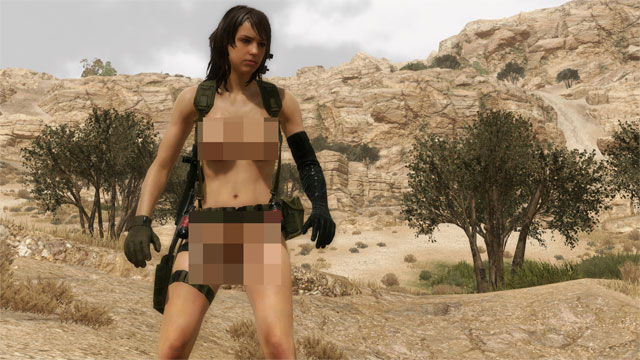
And there’s a mod to make her even naked-er, because of course there is.
Yeah, but see, that’s stupid!
Sure, but that doesn’t make it not the answer to the question.
It also brings us to this uncomfortable truth: the answers aren’t going to please everyone. There comes a point where a given person will find no possible answer satisfying, because of some fundamental disconnect with the source material as presented.
I find the biggest disconnect when it comes to Metal Gear is this: in the Metal Gear universe, magic is real. To a lot of burning questions, the answer is simply, “Magic, full stop.” And by magic I mean literal, supernatural, Harry-Potter-and-Gandalf magic. Mushrooms recharge batteries because magic. Infinite ammo bandana, because magic. Guy takes headshot and runs on water because magic. Mean psychic ghost because magic. Immortal horse because magic. Kuwabara kuwabara, because magic.
Sometimes the magic hides behind SCIENCE!. Vampire man because SCIENCE!, perfect stealth camo because SCIENCE!, flying rocket arm because SCIENCE!. But when you dig deep into these and try to explain the science, eventually you hit magic. The Phantom Pain falls all over itself desperately trying to explain the biology behind vocal chord parasites, but the idea is just incompatible with our understanding of the physical sciences, and it’s magic the rest of the way down.
Whether you start at Metal Gear, the first published game, or Snake Eater, the first chapter chronologically, the series establishes supernatural elements early on and never lets up. If “a wizard did it” doesn’t sate your curiosity as to why there are insta-death hamsters and talking ghost arms in your sci-fi tactical espionage story, it’s likely because some part of you just doesn’t want them there.
–
Are nanomachines magic?
No, but kinda.
Nanomachines (or, in The Phantom Pain parlance, parasites) are not, in the “magic is real” sense outlined above, magic. They aren’t supernatural, and there is at least one person — Naomi Hunter — who knows exactly how they work and what they can do. Shortest explanation ever: they are cell-sized machines injected into the bloodstream which re-program the human body.
In the narrative sense, they are a kind of “plot magic”. They’re a catch-all explanation for any weird or nonsensical thing characters need to be able to do in Metal Gear, which Kojima did not want to attribute to supernatural forces.
–
Have we established enough of a baseline now to start asking real questions?
Yes. Yes we have. Let’s start with an easy one.
–
Which games are canon?
The Metal Gear timeline consists of nine games:
- Metal Gear Solid 3: Snake Eater (1964)
- Metal Gear Solid: Peace Walker (1974)
- Metal Gear Solid V: Ground Zeroes (1975)
- Metal Gear Solid V: The Phantom Pain (1984)
- Metal Gear (1995)
- Metal Gear 2: Solid Snake (1999)
- Metal Gear Solid (2005)
- Metal Gear Solid 2: Sons of Liberty (2007/2009)
- Metal Gear Solid 4: Guns of the Patriots (2014)

This series is mostly about guns and mustaches.
Are Portable Ops and Rising canon?
They are if you want them to be. Truth is, it doesn’t matter. Nothing happens in these two titles that directly contradicts the other games; the timeline works whether you include or omit them.
–
Why does Naked Snake have a Raiden mask in his inventory?
He doesn’t. He has an Ivan Raidenovich Raikov mask.
In a radio conversation about the mask, SIGINT explains he developed the eerily lifelike Raikov mask for an operation to infiltrate GRU. The operation was scrapped before the mask was used, but SIGINT was so impressed with his own work that he squirreled it onto Snake’s person before Operation: Snake Eater, you know, just in case he needed it.
There is no in-universe reason for Raikov and Raiden’s similarities. Sometimes people — even weird albino prettyboy people — look like one another.
–
Where was Grey Fox during The Phantom Pain? (etc.)
This is the most common form of “unanswered” Metal Gear question. In a franchise featuring dozens of characters and spanning six console generations, some folks are unsatisfied without a complete accurate timeline of every character’s life. Grey Fox is the fan favorite, but there are others: Ocelot during Peace Walker? Raiden during Metal Gear Solid? Colonel Campbell during Sons of Liberty? Dr. Madnar during, well, any of it?
The answer is: it doesn’t matter. Wherever those characters were, and whatever they were doing, they weren’t integral to the story in question, and their actions didn’t shape the structure of the narrative as a whole. They weren’t in those games because they weren’t in them.
Still, it’s pretty easy to infer what a character was doing during the gaps in their timeline. We know Grey Fox kills Naomi Hunter’s parents at some point in the late 70s or early 80s while Big Boss is in a coma. Over a decade later he becomes a decorated member of FOXHOUND, gets punched to death by Snake in Zanzibar Land, then is revived as the Cyborg Ninja. In the intervening time, during the late 80s and early 90s, he was probably working with Big Boss.
Remember, we don’t actually play as Big Boss in The Phantom Pain; we play as Venom Snake. It makes perfect sense for a character to be working for Big Boss during that timeframe, because Big Boss is off somewhere else, doing Big Boss things. While Venom is playing grab-ass with Skull Face in Afghanistan, Big Boss is elsewhere, making contact with Sniper Wolf, Vulcan Raven, Decoy Octopus and, yes, Grey Fox.
–
What does Code Talker mean by “Eyes on Kazuhira”?
This is a particularly frustrating loose end, because it stinks of a plot thread abandoned because The Phantom Pain was woefully unfinished.
Lacking some definitive answer, we can infer what Code Talker probably meant in the context of the rest of his other nonsensical parasite-stasis word salad. Kaz Miller is, putting it delicately, not the most well-adjusted man on the oil rig. He has been viciously tortured, mind and body. He has been cruelly and — from his perspective, unnecessarily — manipulated by Cipher. Everything he ever built has been destroyed, and then he finds out the man he reveres most, Big Boss, abandoned him and pawned him off on a secret doppelganger. This fact was revealed in trust to Ocelot rather than himself.
Kaz doesn’t work with Venom or Big Boss at any point after The Phantom Pain, and the break-up is not amicable. He chooses to support Solid Snake instead, and as of Metal Gear 2 is actively working against Big Boss’s interests. He is a bitter man, obsessed with revenge, who spends the entirety of The Phantom Pain railing against the other Diamond Dogs high-ups. Oh, and he extorts money to secretly invest in a hamburger restaurant.
So hey, “Big Boss”, keep your eyes on that Kazuhira Miller. He’s a loose cannon set to go off.
–
When did Big Boss become a villain?
This is one of the hottest Metal Gear questions out there, and one of the easiest to tackle, because the answer is “…seriously?” As in, “Weren’t you paying attention?”
The marketing blitz for The Phantom Pain led a lot of players to believe we would get a definitive, clear-cut moment where Big Boss stopped being a “good guy” and started being a “bad guy”. This ended up not happening, which should be not at all surprising to anyone who played the previous few games. Depending on your perspective, Big Boss was never a “good guy” in the first place.
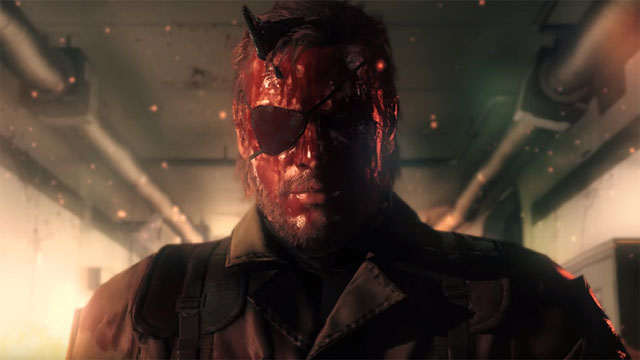
Pictured: a good guy. (Maybe.)
During his denouement in Guns of the Patriots, Big Boss says, “Ever since the day I killed The Boss… with my own hands… I was already dead.” If you need a singular moment in time where Big Boss lost his path, that was probably it.
Or, you could answer this by simply saying “Peace Walker“. That game has Big Boss doing all the things that made him the villain of the MSX games: building a private army, stealing resources, deploying child soldiers, seizing nuclear weapons, developing Metal Gear. Of course, we-the-player didn’t recognize Big Boss as a “bad guy” in that game because the story is told from his perspective. When he’s up to all those same shenanigans in Zanzibar Land, and our controller is plugged into Solid Snake instead, things look very different to us.
The broadest explanation is that Metal Gear is not a story about “good guys” and “bad guys”. It is not Star Wars. With the possible exceptions of Colonel Volgin and Psycho Mantis, most every character in the saga has sympathetic motives. Even Ocelot, in his own crazy way.
–
How did Big Boss go back to the US? And why?
He didn’t. Venom Snake did, posing as Big Boss.
–
Okay, smart ass, how did Venom Snake go back to the US? And why?
We don’t have a lot of data on the particulars. When the games do reference this, it’s always in passing. The timeline roll from The Phantom Pain simply says “1995: While commanding special forces unit FOXHOUND from a position in the US military…” and glosses over the transition. I’m betting the answer is surprisingly boring, though. The US didn’t want Big Boss to leave in the first place, so when “he” offered to come back, they welcomed “him” openly.
Big Boss (or Venom Snake, who from the perspective of the US military effectively is Big Boss) spent the decade after Snake Eater trying to build his private army, somewhat unsuccessfully. He finally gets established in Peace Walker, but doesn’t actively work against the US’s interests. He stops the maniacal plan of a rogue CIA chief, saving America from a huge headache. During that mission he speaks directly to agents at NORAD, and those Americans who know him personally have great veneration for him.
Absent any evidence of MSF or Diamond Dogs openly declaring war against the US or one of its allies, it’s reasonable to conclude that Venom-as-Big-Boss just rolled up at some point in the early ’90s and said, “Hey guys, I got all that private army stuff out of my system, I’m ready to come home and work for Uncle Sam again.”
As for why, well, one of the most useful places you can be if you’re setting up a rogue military country like Outer Heaven or Zanzibar Land would be amidst America’s top brass. Indeed, the big twist of the original Metal Gear is that “Big Boss” tried to sabotage the mission by sending an unproven soldier on what was supposed to be a suicide mission.
Unfortunately that soldier was Solid Snake and things did not end well for either Big Boss.
–
Where was Solid Snake raised?
The Les Enfants Terribles program was masterminded by Zero and The Patriots, but was officially developed by the US government. Eli (Liquid Snake) was sent to the UK and eventually escaped. We’re never explicitly told what happened to David (Solid Snake), except that by 1991 he was “sent to the battlefield”. We do know that Snake was a Green Beret and later a member of FOXHOUND, both of which are American military organizations.
All signs point to Liquid’s infodump at the end of Metal Gear Solid being accurate: the US military kept a watchful eye on Solid Snake, grooming him to eventually become the next Big Boss.
–
What ever happened with OILIX?
Nothing. For some reason, Dr. Marv’s research was never implemented, and his work was never duplicated after he died. There are numerous possible explanations. Maybe the data cartridge recovered at the end of Metal Gear 2 was corrupted by chocolate or hamster droppings. Maybe it was stolen by Russian double agents or supressed by The Patriots. Maybe OILIX was Marv’s scientific superpower and it was just impossible to implement without him. Maybe there was a critical flaw in the production process that wasn’t spotted until after Marv’s death. Maybe it was eaten by Y2k.
At some point in the five years between Metal Gear 2 and Metal Gear Solid the oil crisis was resolved to such satisfaction that OILIX became unnecessary.
–
Is Dr. Clark male or female?
Female. Dr. Clark is Para-medic.
There is a lot of in-universe misinformation surrounding Dr. Clark. There are conflicting reports as to her identity in the ’90s because she is a Patriots founding member doing cutting edge (and highly illegal) research involving cloning, cybernetics, and just a smidge of human torture. People who know of her work but have never met her personally, such as Naomi Hunter, assume Dr. Clark is a man because most mad scientists turn out to be men. The people who have met her personally were probably all murdered by the Cyborg Ninja.
–
Which Metal Gear Solid ending is canon?
Whichever one you want. The two endings exist in a kind of continuity superposition, and the rest of the timeline works whether Snake escapes with Meryl or Otacon. Whichever one he doesn’t rescue somehow miraculously survives. If there’s one thing Metal Gear is good at, it’s having important (and sometimes not-so-important) characters miraculously survive offscreen. (And sometimes onscreen!)
Either way, Snake and Meryl persue a brief romantic interlude, then go their separate ways. Meryl ends up working for the Army in Rat Patrol 01, Snake ends up founding Philanthropy with Otacon, and he has both the stealth camo and infinite ammo bandana as of Sons of Liberty. Lucky bastard.
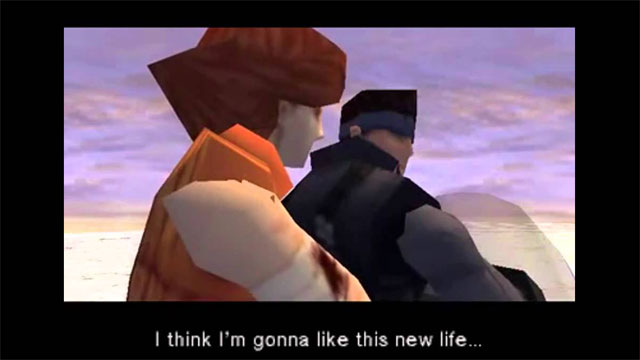
“…where we immediately break up and go back to what we were already doing.”
What does La-li-lu-le-lo mean?
The La-li-lu-le-lo are The Patriots. Specifically, it’s the string of syllables second-level agents of The Patriots are programmed by nanomachines to hear and say instead of “The Patriots”.
It works a bit like content filters on web forums. When an agent’s nanomachines detects the phrase “The Patriots” in reference to the secret shadowy organization nobody is supposed to know about, they covertly replace the words with “La-li-lu-le-lo” in the agent’s brain. Such second-level agents include Scott Dolph, Richard Ames, and Meryl Silverburgh; basically anyone The Patriots want to make use of without revealing themselves to.
It is never revealed how the nanomachines can differentiate usage of their name from, say, the sportsball team.
–
Why is Solidus so much older than Liquid and Solid Snake?
Solidus is actually younger, by a couple of years.
All of Big Boss’s clones were genetically modified to age faster than normal humans. This is why Snake looks like a 70-year-old math teacher in Guns of the Patriots. Solidus must have been modified to age at an even more accelerated rate.
Why would The Patriots do this? Les Enfants Terribles was the final straw for Big Boss, and the moment he decided to break away from Zero. Once this happened, Zero must have been more desperate than ever for a Big Boss figurehead to his organization. When the perfect clone — Solidus — was implanted, he put a rush job on things. 25 years later Solidus looks like a 50-year-old man, and is put into place as POTUS.
–
Why does Raiden keep leaving Rose?
Sons of Liberty and Guns of the Patriots both end with Raiden reconnecting with his lady lover Rosemary, only to be back to his old emo-ninja’ing self in time for the next title. Leaving aside the joke answer of Rose being a horrible shrew nobody would want to stay married to, it turns out it’s pretty hard for a genetically-altered and deeply-traumatized homicidal supersoldier jacked up on nanomachines to stay settled. After a short time playing house Raiden feels drawn back to the battlefield, just like the countless legendary soldiers before him.
–
What happened to Naomi and Mei-Ling’s accents?
Canonically, these two characters have American accents.
Around the time of Sons of Liberty, a remake of the original Metal Gear Solid came out for Nintendo Gamecube called The Twin Snakes. The game had updated graphics, re-dubbed audio, and improved gameplay, but is considered non-canonical by later sequels. Whenever flashback footage of Metal Gear Solid is shown in later games, it is consistently pulled from the PS1 original, as though the whole Metal Gear universe were made of low-poly models in the mid-aughts.
The one exception is the voice acting. Metal Gear Solid has legendarily poor quality voice acting, so when it came time to put various audio clips into Guns of the Patriots cutscenes, they were pulled from The Twin Snakes instead.
As for why the accents were changed for The Twin Snakes, that’s anyone’s guess.
–
How have The Patriots been dead for over 100 years?
They aren’t dead, at least, not all of them. As of the end of Sons of Liberty, when this twist is revealed, Patriots founders Ocelot and EVA are still alive and working. Big Boss and Zero are biologically alive, but no longer active because of various Patriots machinations. And none of them are 100 years old.
It is revealed in Guns of the Patriots that the identities Snake and Raiden pulled out of GW were bogus, because part of how Cipher hides The Patriots is with layers and layers of confusing misinformation. Controlling information is Cipher’s most powerful weapon throughout the years, and is central to his many schemes.
As it turns out, the information wasn’t really bogus so much as useless. The identities revealed to Snake were probably the members of the Wisemen’s Committee, the original alliance of American, Russian and Chinese contributors which amassed the Philosopher’s Legacy. This happened just after World War I… or about a hundred years before the events of Sons of Liberty. Historically interesting information, but totally unhelpful to Snake’s current situation.
–
Who is really in charge of The Patriots? Why are they so corrupt?
As of Donald Anderson’s death in Metal Gear Solid, nobody.
Dr. Strangelove began development of The Patriots AI in the 1980s, but she died before its completion. AI was Strangelove’s scientific superpower, so after her death no one else comes close to what she was able to accomplish. (This explains why her AI machines were so sophisticated in Peace Walker, while the Metal Gears in Guns of the Patriots moo and fall down a lot.)
Major Zero continued development on the AI in its imperfect state, but he wasn’t able to oversee it either, since Skull Face had poisoned him and he spent the next 30-ish years slowly losing his mind.
Zero mentions that Donald (aka SIGINT) was running a lot of the day-to-day tasks in one of his tapes in The Phantom Pain. And this was probably fine until Ocelot tortured him to death in Shadow Moses. From that point on, the AI was spinning without supervision, running the same processes over and over, causing trouble for everyone. Over the decades, random mutations in the AI’s subroutines ended up having a corrupting influence. The AI organized the S3 plan in Sons of Liberty and eventually invented the War Economy in Guns of the Patriots.
–
What is the S3 Plan, and what the hell happens at the end of Sons of Liberty?
The last hour or so of Sons of Liberty is where Kojima intentionally went full-on batsplat banana sandwich on his players. The one-line summary of this 40-minute labyrinthine infodump is, “The Patriots AI went crazy.”
The S3 Plan is the Mutant Crazy AI playing its hand at being Cipher.
Solidus tells Raiden that S3 stands for “Solid Snake Simulation”, and he believes this to be true. The idea is The Patriots concocted a Shadow Moses-like live exercise to see if a green recruit with minimal combat experience could be turned into the next Solid Snake. It’s kind of a 21st century version of Les Enfants Terribles — instead of growing a new supersoldier from scratch as a clone, now we can make one on the fly with rudimentary VR training and extreme live fire.
Solidus was fed bad information by The Patriots, however, and the AI explains to Raiden what S3 really is: Selection for Societal Sanity. The AI has decided that there is too much raw information out there, and wants to control the flow of it to such a degree that a person’s entire life can be fabricated around him. That’s what happens to Raiden: he’s given a fake girlfriend, a fake colonel, a fake Shadow Moses playground to kick around in, a fake FOXHOUND to join, etc. Virtually nothing Raiden believes to be true actually is, thanks to The Patriots running circles around him.
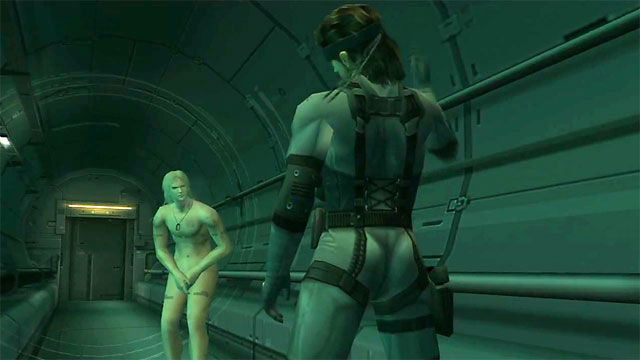
In other news, Raiden beat Quiet to full frontal by 14 years.
Who does Revolver Ocelot work for?
In Snake Eater Ocelot works for the CIA. After Snake Eater Ocelot works for Big Boss.
Ocelot is the first of many characters who becomes absolutely infatuated with Big Boss. Even way back as Naked Snake, Big Boss has a sort of inspiring magnetism that made people want to follow him. This magnetism is so inexplicably powerful that even people who want to kill him — Quiet, Paz, countless soon-to-be-Fultoned nameless grunts, and of course Ocelot — end up seeking his approval. This overwhelming charisma is what makes him so special to The Boss, and so integral to Cipher and The Patriots.
And Ocelot falls hard. He so badly wants senpai to notice him that, at one point in Snake Eater, he steals all of Snake’s food and eats it in an effort to be more like him. More tellingly, in an unguarded moment towards the end of the game, Ocelot insists he and Snake learn each other’s real names. This is perhaps the one moment in the entire saga where Ocelot is being purely genuine.
After Big Boss is burned to death in Metal Gear 2 and his biomass is swept up by The Patriots, Ocelot makes it his life’s mission to recover the remains and destroy The Patriots. This isn’t sentimentality; Big Boss’s remains are the literal, physical key to locating The Patriots. At this point in time the AI still sees Ocelot as an especially valuable asset, so Ocelot is very careful to position himself without blowing his cover.
At his most convoluted, Ocelot is four levels deep: Liquid doesn’t know he works for Solidus, who doesn’t know he works for The Patriots, who don’t know he works for Big Boss. The masterstroke here is that, on some level, Ocelot actually does work for Liquid and Solidus. They both want the same thing he does. If either of their crazy terrorism plans succeeds, he can end the charade and assist them directly. If they fail, he has just enough plausible deniability to maintain the ruse and bide his time.
–
So who or what is Liquid Ocelot?
Ocelot, pretending to be Liquid Snake.
There was a point when Liquid’s ghost arm was actually in partial control. During the cutscenes in Sons of Liberty where Liquid speaks through the arm, that is really Liquid and he is really taking over. This doesn’t sit well with Ocelot,0 so he has the arm removed and replaces it with a synthetic one. He doesn’t reveal his new robot arm until the end of Guns of the Patriots.
According to Big Boss, Ocelot kept up the Liquid ruse by undergoing a treatment of drugs and nanomachines to trick his mind into believing he was Liquid Snake in a new body. (A similar process worked once before, in The Phantom Pain, to trick his mind into believing Venom Snake was the real Big Boss.)
After Big Boss is burned to death in Metal Gear 2, Ocelot’s goal is to locate his body and bring down The Patriots. The AI doesn’t realize this, though, which is why it seems like Ocelot is a good little Patriots soldier all through Sons of Liberty. In that game, what comes across to the player is that Ocelot and Liquid’s ghost arm are working at cross purposes.
We’re given an explanation for why Ocelot re-writes his brain during Big Boss’s exposition at the end of Guns of the Patriots: “in order to fool the System”. Becoming Liquid’s mental doppelganger allows Ocelot to actively work to destroy The Patriots without The Patriots twigging to his betrayal. The AI believes he’s Liquid and acts accordingly: by tapping Solid Snake and sending him to the battlefield.
–
How can Snake be part Japanese, if his parents are EVA and Big Boss?
In the same conversation where EVA reveals she is Snake’s mother, she explains he was conceived via in vitro fertilization. The egg donor was a lab assistant of Dr. Clark, a character who is only ever identified as “a healthy Japanese woman”.
Apparently, Vulcan Raven can sense the influence of healthy Japanese women even years after they’ve been murdered by Cyborg Ninjas.
–
How is REX still operable, and how is it a match for RAY?
REX is the best Metal Gear ever built. It is the Cadillac of Metal Gear. It is an artisinal, home-brew Metal Gear whose secret ingredient is love.
I keep mentioning this idea of a “scientific superpower”. Sometimes, a scientist in Metal Gear has such incredible aptitude for a field of study that their accomplishments and insights are presented as being literally unique. As in, if they die, their field dies with them, never to be replicated. There’s a good reason so many Metal Gear games start you off by sneaking into a base to rescue a scientist.
Dr. Strangelove’s scientific superpower was developing AI. Naomi Hunter’s was the implementation of nanomachines. And Hal Emmerich’s is building Metal Gear.
While REX is not as big as Sahelanthropus nor as versatile as RAY, it is the only Metal Gear model that displays human characteristics. Otacon speaks of REX as a person; he specificially designed it with a weakness to give it a certain je ne sais quoi. None of the Metal Gear superscientists like to see their creations destroyed, but Otacon actually takes it personally. To him it’s not, “Liquid has a really powerful battle tank,” but rather “Liquid stole my friend, who happens to be a powerful battle tank.” He takes it personally again, nine years later, when he realizes what Liquid Ocelot wants with its railgun.
It’s this connection between a boy and his bestest battle tank buddy that accounts for REX’s ʜᴜᴍᴀɴ ᴇʟᴇᴍᴇɴᴛ. Otacon is so good at Metal Gear that you can cover REX in chaff, pelt it with stingers, carpet bomb it, leave it to rust for ten years in a wet Alaskan bunker, and all it takes to get it back up and running is a pep talk and some Street Fighter moves.
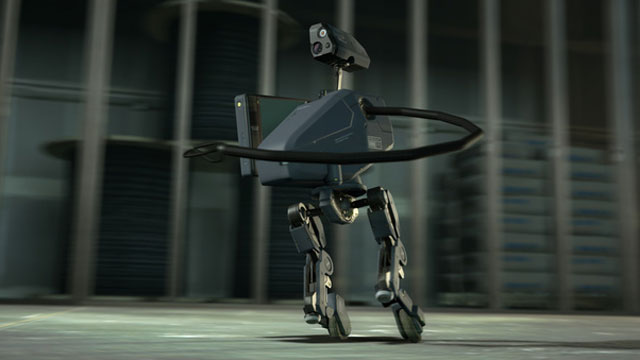
REX’s little brother is pretty awesome, too.
I have another question?
That’s not a question.
–
Okay but I have one anyway?
Sure, leave it as a comment to this post and I’ll do what I can to write a follow-up someday.
–
Didn’t you do a bizarre and hilarious rap song about Ocelot?
Yes. Yes I did. Thanks for reading!
“Metal Gear Solid has legendarily poor quality voice acting”
Them are fighting words! I played a lot of CD-based games in the mid to late 90s and there was certainly plenty of atrocious voice-acting to be found. But Metal Gear Solid had a superb cast with some of the best performances ever put into a videogame to that point. Paul Eiding (Col. Campbell) and Cam Clarke (Liquid Snake) are veteran voice actors with IMDB entries miles long who did commendable character actor style performance in their roles. Jennifer Hale (Naomi Hunter) is one of the top voice actors in the field for the last fifteen years and single-handedly made playing Mass Effect as FemShep a superior experience to MaleShep. Christopher Randolph perfectly embodied the timid scientist with his performance as Otacon. And David Hayter inspired a generation of kids to try and speak in a gravelly rasp with his iconic performance as Solid Snake. Eventually Hayter’s voice started to break down in his second decade of voicing Snake but nonetheless it still felt as something of a betrayal to have him unceremoniously replaced with Keifer Sutherland in MGSV (especially since The Phantom Pain featured a multitude of scenes where Big Boss was inexplicably mute–whether due to Sutherland’s hourly rate being too costly to keep him in the studio to record the reams of optional dialogue typically featured in codec calls, etc or if it was because the game was essentially unfinished is something we’ll probably never know). A richer script being voiced by Hayter would have certainly improved The Phantom Pain markedly (in fairness, a fleshed out script with Sutherland would have been great, too).
The performances in MGS are fine, but the actual sound quality is not. I’ve heard stories that the English voice acting wasn’t even recorded in a studio, and that a lot of reverb had to be added to mask imperfections. But yeah, at least someone was paying attention to the performances themselves, which definitely wasn’t the standard of the time!
Grousing aside, I finally got around to playing through the MSX versions of Metal Gear & Metal Gear 2 recently. I was amazed at how much Metal Gear 2 plays like a rough draft of Metal Gear Solid and how many elements from the game were recycled.
On the one hand Metal Gear 2 feels like a game far ahead of its time. I can’t think of any other games from 1990 that were as large, as deep, or as complex in plot and gameplay. On the other hand, it kind of feels like Kojima treated Metal Gear 2 as a rough draft in the sense that Metal Gear Solid completely superseded it. Metal Gear Solid onward Kojima put a huge emphasis on maintaining characters across games. Meryl, Campbell, Otacon, Gray Fox, Naomi Hunter, Miller, Eva, Ocelot, Para-Medic, Sig-Int, are all featured across multiple games and the trajectory of their lives are outlined even if they aren’t featured in every game.
Whereas since Metal Gear 2 is the rough draft characters like Holly, George Kasler, Dr. Madner, and Dr. Marv aren’t incorporated into subsequently released game (and Gustava Heffner doesn’t really have a story that allows her to be in any other games in the series, though I bet Naomi Hunter would have really hated her!). I’m sure Kojima could have incorporated Dr. Madnar into The Phantom Pain if he had been inclined to do so.
How did Cyborg Ninja get on Shadow Moses Island?
He is a cyborg and also a ninja. He probably backflipped there.
Snake got to the island in a submarine, and got away from it on a snowmobile. Gray Fox could have arrived by either of those methods, or any other method really.